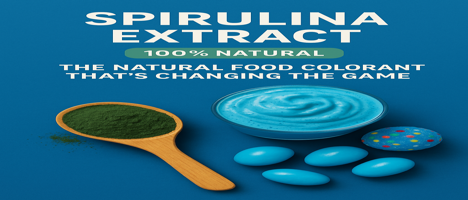Spirulina Extract as Natural Colorants
🔬 What Exactly Is Spirulina Extract?
Spirulina is a microscopic blue-green algae (technically a cyanobacteria) that grows in freshwater. It’s long been praised for its health benefits—packed with protein, vitamins, minerals, and antioxidants.
But when it comes to color, the magic lies in phycocyanin, the blue pigment naturally found in spirulina. Through a gentle water-based extraction process, manufacturers isolate this pigment to create a vivid, natural blue colorant.
No harsh chemicals, no synthetic ingredients—just pure, plant-based color.
🍭 Where Is It Used?
Spirulina extract has already made its mark in various food and drink categories. You’ll often spot its electric blue touch in:
Candy – Think gummies, lollipops, and hard candies
Ice Cream & Yogurt – For that dreamy blue swirl
Smoothies & Drinks – Especially in trendy juice bars and wellness shots
Baked Goods – Like unicorn cupcakes and ocean-themed cakes
Decorative Icing & Frosting – Hello, Instagram-worthy desserts!
Even better? It can be blended with other natural colorants (like beet or turmeric) to create purples, greens, and more.
✅ Why Choose Spirulina Extract?
There are plenty of good reasons food brands and home bakers alike are turning to spirulina extract:
✔ It’s 100% Natural
No synthetic dyes. No petrochemicals. Just algae-derived color.
✔ It’s Better for the Planet
Spirulina farming has a small environmental footprint, making it a sustainable choice for eco-conscious brands.
✔ It’s Label-Friendly
Want to keep your ingredient list clean and recognizable? Spirulina extract fits right in.
✔ Health Halo Appeal
Though its nutritional benefits may decrease during processing, just seeing “spirulina” on a label adds a perception of wellness for many consumers.
⚠️ The Challenges (Because Nothing’s Perfect)
As amazing as spirulina extract is, it does come with a few caveats:
Heat & pH Sensitivity: It doesn’t love high heat or acidic environments, which can dull the color.
Higher Cost: Being natural and less mass-produced than synthetic dyes, it tends to be pricier.
Regulatory Limits: Not every country allows it in all food categories yet, so always check the rules in your region.
🔮 The Future Looks Bright (Blue)
With innovation in food science (like microencapsulation and formulation tweaks), manufacturers are already finding ways to improve spirulina’s stability and lower production costs.
As clean-label demands grow and synthetic dyes fall out of favor, spirulina extract is poised to become a key player in the future of food coloring—bright, beautiful, and better for you and the planet.
💬 Final Thoughts
Whether you’re a food developer looking for a natural alternative or a health-conscious shopper curious about those pretty blue treats—spirulina extract is worth knowing. It’s more than just color; it’s part of a bigger shift toward transparency, sustainability, and mindful eating.
So next time you bite into a blue gummy or sip a sapphire smoothie, check the label. If it says “spirulina extract,” you’re tasting the future.
- Jenson Ching
- Fufaton Candy
- 2025-06-23

